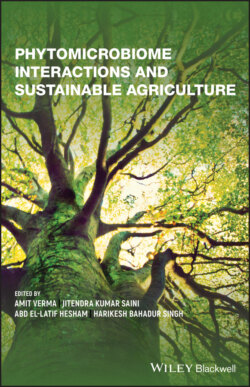Читать книгу Phytomicrobiome Interactions and Sustainable Agriculture - Группа авторов - Страница 15
1.2 Root Exudates Composition: Collection and Analysis
ОглавлениеRoot exudates chemicals secreted through plant roots are necessary for the soil environment as well as for the plant. Root exudates analysis is quite essential in order to know the function of chemicals present in the exudates. There were several procedures to know the compounds present in the root exudates, such as high performance liquid chromatography (HPLC), UV, visible absorption, transcriptome analysis, metabolomics, proteomics, and gas chromatography–mass spectrometry (GS/MS) utilized to determine various compound present in exudates (Table 1.1).
There are several methods of root exudate collection from mature trees. The characterization of its composition has revealed the hidden capacity of root exudates in stimulating microbial activity and decomposition activity of organic soil matter (Phillips et al. 2008). However, the method depends on a realistic architecture to resemble the natural rhizosphere and doesn't accompany an accumulation of other compounds usually not present in exudate. Root secretion possesses several biological active compounds that reduce the dependency on chemicals in the soil and is safe for environment (Carlsen et al. 2012). To avoid the impact of microbes on root exudates profiles, sterilized water cultivation systems were adopted (Badri et al. 2008; Oburger et al. 2013; Strehmel et al. 2014). Furthermore, hydroponics strategy permits exudate sampling with minimum root damage. Root exudates collected in nutrition solution at three and seven days from model organism Arabidopsis thaliana for analysis by LC–MS revealed the difference in wild and mutant root exudates composition (Badri et al. 2008). As days increase, root exudates secretion increases, as shown in the seven‐day root exudates collection period in a nutrient solution that it is quite sufficient for analysis of chemical composition through ultraperformance liquid chromatographic–electrospray‐ionization technique–time of‐flight mass spectrometry (UPLC/ESI‐QTOFMS). This estimated 103 compounds includes different classes of biological compounds related to nucleic acids, secondary metabolites, amino acids, and defense molecules (Strehmel et al. 2014). In contrast, six hours of exudate of Zea mays exposed to different nutrient deficiencies were analyzed through HPLC and statistics were used to reveal the strong influence of a nutritional status of a plant to cope with a limiting nutrient supply (Carvalhais et al. 2010). The limitation of such hydroponic medium collection of exudates is a very different type of plant development as compared to a natural solid substratum growth of a plant. Therefore, a solid medium for exudate collection is designed utilizing vermiculite, sand, perlite, etc., which mimics the rhizospheric conditions more closely. Transcriptome and other omic technologies involved in the analysis of exudate from different microbes reveals the gene and protein involved in the plant microbe's interaction. However, root exudate collection from the natural rhizospheric region is still one of the best methods to collect and analyze root exudate of plants under different conditions. Apart from this, there is a requirement of keeping the physical parameter near to the natural conditions, especially pH and temperature conditions, during the collection of root exudate. Through root exudation analysis we came to know about the impact on microbes and function in rhizosphere, however, its collection is a major constraint during its analysis, due to a lower concentration and presence of many compounds in several times a higher concentration, which is irrelevant to root exudation. So, there is a requirement of using a combination of collection methods to analyze the root components with high accuracy in order to assign the function imparted by the respective component in the growth and development of plants.
Table 1.1 Root exudation of different plants: biochemical nature of root exudate components and techniques involved in characterization.
| Plant System | Exudate Profile | Technique | References |
|---|---|---|---|
| Maize (Zea mays) | Wide variety of fatty acids, nitrogenous compounds, organic acids, steroids, and terpenoid derivatives | GC–MS and 1H NMR | Lima et al. (2014) |
| Lettuce (Lactuca sativa) | Exudate comprises amino acids, amides, sugars, sugar alcohols, organic acids | GC–MS | Neumann et al. (2014) |
| Arabidopsis | Varied composition of sugars, sugar alcohols, amino acids and phenolics at different developmental stages | GC–MS | Chaparro et al. (2013) |
| Tall fescue (Lolium arundinaceum) | Sugars, polyols, growth factors and vitamins, lipids, amines, phenolics, carboxylic acids, nucleosides and others | GC‐(TOF) MS (gas chromatography –time of flight–mass spectrometry) | Guo et al. (2015) |
| Taro plants (Colocasia esculenta) | Organic acids like lactic acid, benzoic acid, m‐hydroxybenzoic acid, p‐hydroxybenzoic acid, vanillic acid, succinic acid and adipic acid. | GC–MS | Asao et al. (2003) |
| Potato (Solanum tuberosum L.) | Sugar quantification | Colorimetric estimation using glucose and fructose assay kits | Hoysted et al. (2018) |
| Maize (Zea mays) | Benzoxazinoids compounds | HPLC‐DAD | Neal et al. (2012) |
| Beech forest (Fagus sylvatica L.) | Low‐molecular organic acids | Ion chromatography | Shen et al. (1996) |
| Sugar Maple (Acer saccharum Marsh.) | Organic acids, carbohydrates, amino acids and amides | Thin‐layer chromatography | Smith (1970) |
| Betula alleghaniensis, Fagus grandifolia, and Acer saccharum | Carbohydrates, amino acids/amides, organic acids, and 9 inorganic ions | – | Smith (1976) |
| Fagopyrum esculentum | L‐tryptophan, fructose‐leucine or fructose‐isoleucine, fructose‐phenylalanine, N‐acetyl glutamic acid methyl ester | UHPLC‐HRMS | Gfeller et al. (2018) |
| Buckwheat (Fagopyrumesculentum) | Caprolactam, an inhibitory allelochemical | 1H and 13C NMR spectra | Tin et al. (2009) |
| Mesocosms having different plants | organic carbon | HPLC‐IRMS system | Karlowsky et al. (2018) |
| Datiscaglomerata | Flavonoids with abundant aglycones | HPLC, UV absorption and LC–MS | Gifford et al. (2018) |
| Medicago spp. | Flavonoids exclusively isoflavonoids | HPLC, UV absorption and LC–MS | Gifford et al. (2018) |
